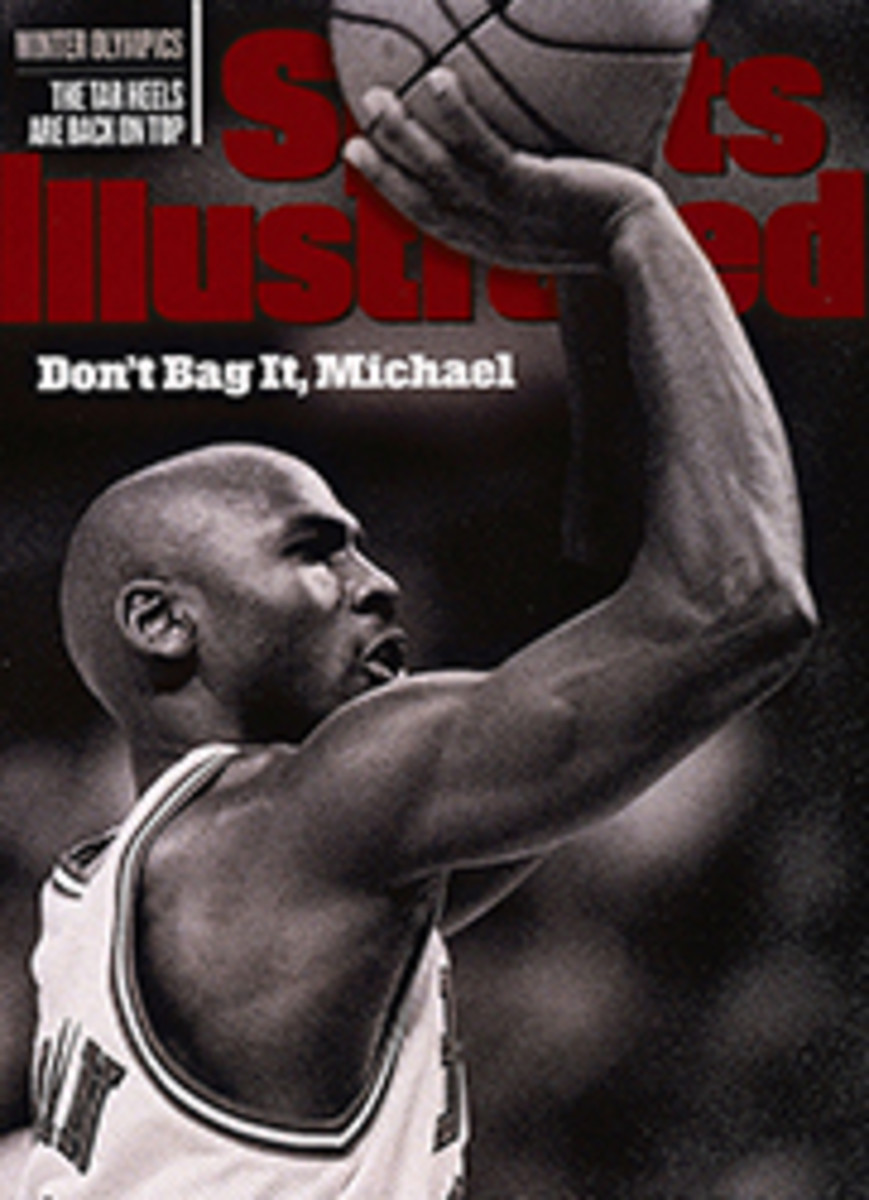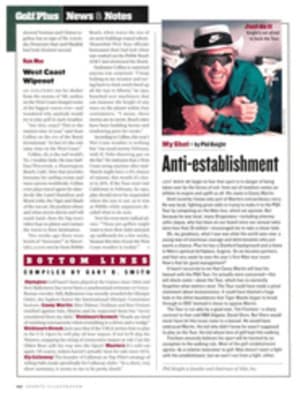
Inside Motor Sports
Shootout at the Shootout
JUMP THE GUN
NASCAR began its 50th-anniversary season on Sunday by harking
back to its roots: with a good old-fashioned flap. No punches
were thrown as of yore, but angry words flew as Jeff Gordon
accused Rusty Wallace of illegally jumping the final restart of
the Bud Shootout bonus race at Daytona. Wallace and Gordon have
a history of jousting on restarts, but NASCAR officials let the
matter slide this time. The infraction was so obvious that much
of the crowd of about 100,000 booed as Wallace drove into
Victory Lane with the first win for Ford's new racing Taurus.
As a caution period ended with one lap to go in the 25-lap
sprint, Gordon was in the lead, but Wallace, running second, was
allowed to line up beside Gordon. "Rusty jumped the start big
time," said Gordon afterward. Generally the race leader controls
the pace of the restart, and the second-place driver must defer.
So, said Gordon, "I kept waiting for a caution flag," which
would have signaled that officials disallowed Wallace's jump and
ordered the field to realign. Officials let Wallace rip,
however, and Gordon fell to the back of the field.
NASCAR officials maintained that they thought Gordon had trouble
with his Chevrolet at the moment of the restart. But Wallace
suspected trickery. "When I took off, I noticed that Jeff stood
on the brakes," said Wallace. "I throttled back a little bit,
and then I took off."
The fiasco may have resulted from a misunderstanding over where
the drivers were supposed to step on the gas during a restart.
"They told us, 'Start at the grass,'" said Wallace, referring to
the spot where the infield grass begins, some 300 yards before
the start-finish line at Daytona. But Gordon maintained that
he'd been told to start in the area of the 76 ball, a large
spherical sign some 100 yards closer to the start-finish line
than the grass.
So forget the official start-finish line. Was it green grass or
76 ball? NASCAR officials couldn't explain the miscommunication.
After half a century of growth, some things haven't changed.
Rookie Watch
THE STEVE AND KENNY SHOW
What looms as the best rookie duel in NASCAR's 50 years--Kenny
Irwin versus Steve Park--begins at this Sunday's Daytona 500 and
is certain to rage all season. "We might not even get the
opportunity to be rookies because people have such high
expectations of both of us," says Park.
What are those expectations? That two drivers of Jeff Gordon's
ability might emerge this season.
The Indianapolis-born Irwin has the best ride ever hooked up by
a rookie: Robert Yates's number 28 Texaco Ford, the same car
that propelled Davey Allison, Ernie Irvan and Dale Jarrett to
stardom. Park, from East Northport, N.Y., drives the Pennzoil
Chevrolet owned by Dale Earnhardt.
Last year Park, 30, won three races and finished second four
times in the Busch Grand National Series. Irwin, 28, who in 1997
raced USAC midget and sprint cars as well as NASCAR trucks,
jumped into his first Winston Cup race--at Richmond in
September--and qualified second and finished eighth.
Irwin has an advantage in a proven team, but Park has more track
savvy. In last year's Busch series he drove 16 of the 20 tracks
on the '98 Winston Cup schedule.
Will Irwin and Park be eyeballing each other on the track? "That
will be the last thing on my mind," Irwin answers coolly. Park,
however, is not above some trash-talking. "I'll be aware of
Kenny when he's directly in front of me," he says. "And I'll be
aware of him when he's behind me two or three laps later."
500 Qualifying
SIBLING REVELRY
As the first brothers ever to fill the front row for the Daytona
500, Bobby and Terry Labonte have never been closer--.07 of a
second apart after Bobby won the pole at 192.415 mph in a
Pontiac and Terry took the outside in a Chevrolet at
192.127--than they were after last Saturday's time trials. But
money might come between brotherly love.
The Daytona winner will collect more than $1 million in prize
money, and the Labontes are two of five drivers eligible for an
additional $1 million bonus. In the No Bull 5, as the bonus
contest is called, any of the top-five finishers in each of five
races--the Daytona 500, the Coca-Cola 600, the Brickyard 400,
the Southern 500 and the Winston 500--can earn the extra million
by winning the next race in the No Bull 5 series. Thus, the
top-five finishers of last October's DieHard 500 at Talladega
(the Labontes, John Andretti, Ken Schrader and Irvan) are
eligible at Daytona. Should one of those drivers win, his take
would blow away that of auto racing's record single payday, the
$1.6 million won by Arie Luyendyk at last year's Indianapolis 500.
This incentive showed in last Saturday's qualifying. The
Labontes filled the front row, Schrader was third and Andretti
was fifth. Still, the Labontes are the only drivers whose
starting positions were guaranteed. The other 40 slots in the
Daytona lineup were to be determined by the order of finish in
Thursday's two 125-mile qualifying races as well as by
time-trial speeds.
CART Spring Training
KEEPING A LOW PROFILE
Team Penske turned heads last week at CART spring training in
Homestead, Fla., not with its lap speeds but with the sleek look
of its new cars and one of its drivers. The cars, designed from
scratch around the Mercedes IC 108E engine, are much more
compact and lower to the ground than any other in the CART
field. "There's not one part on the car that was on last year's
other than the wheels," says owner Roger Penske. "Overall, it's
the best car we've ever built."
The Mercedes engine is 31% smaller and 50 pounds lighter than
last year's model but generates the same 850 horsepower. The
petite powerplant allowed the Penske designers to lower the
car's center of gravity by reclining the driver's seat and to
improve handling by redistributing more of the car's 1,550
pounds from the rear to the center. "Cornering is definitely the
biggest difference," says driver Al Unser Jr. "We're still
developing this car and there's huge potential in it, but
already it's definitely an improvement over last year's."
Unser says the car inspired him to lighten his own load. "Roger
spends a ton of money to make his race car lighter," says Unser,
who shed 20 pounds in the off-season largely by cutting back on
candy and soda. "He might spend $200,000 to make the car 10
pounds lighter. The least I could do was lose some weight."
--Loren Mooney
For more racing news from Ed Hinton, check out www.cnnsi.com
COLOR PHOTO: GEORGE TIEDEMANN FAST COMPANY Wallace's win was allowed to stand despite his obvious infraction on the restart. [Rusty Wallace holding trophy with people wearing costumes]
COLOR PHOTO: MIGUEL COSTA JR. LAID BACK In Penske's new machine, the driver sits lower and farther back than in other cars. [Race car owned by Roger Penske]
The Deal
1.701
The average margin of victory, in seconds, of the 31 Winston Cup
races that ended under a green flag in 1997. It was the closest
racing since 1990, when the margin was 1.580. Last year the Indy
Racing League's average margin of victory was 3.539 seconds;
CART's was 3.752.
FAST FACTS
Team Chemistry
This season six NASCAR owners will field teams with more than
one car, the most ever in Winston Cup racing. Owners are wising
up to the fact that drivers from multicar teams have come to
dominate NASCAR over the past decade. Last season more than 80%
of the Winston Cup's 32 races were won by drivers from the
stables of just three owners--Rick Hendrick (11 victories),
Robert Yates (8) and Jack Roush (7), who says that managing his
five-car racing empire is like "fishing with five poles." The
chart below shows how multicar teams have taken hold of the
circuit.
Multicar Multicar Pct. of
Year teams team wins races won
1990 2 2 6.9%
1991 2 4 13.8%
1992 3 8 27.6%
1993 4 7 23.3%
1994 4 10 32.3%
1995 3 14 45.2%
1996 3 18 58.1%
1997 4 26 81.3%

